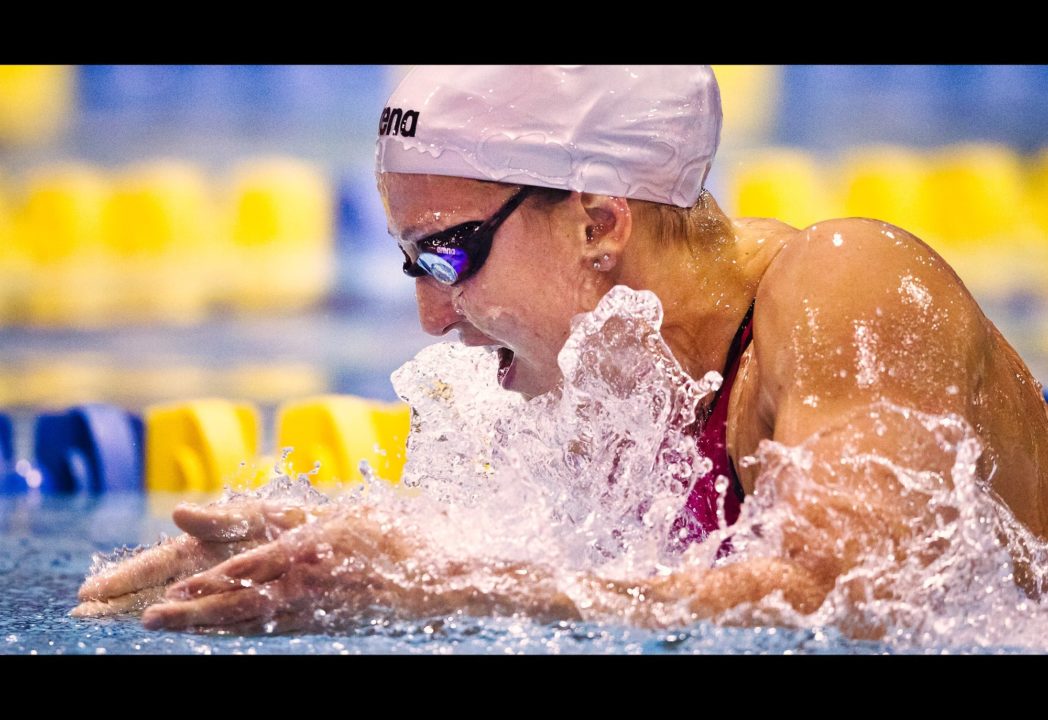Courtesy of Gary Hall Sr., 10-time World Record Holder, 3-time Olympian, 1976 Olympic Games US Flagbearer and The Race Club co-founder.
Breaststroke is the most inefficient and slowest of the four strokes. It is also the key to a successful IM. Furthermore, it is the one stroke that seems to come and go like the wind, and is perhaps the most challenging to master. How can a swimmer do so well at breaststroke one season, only to find that he or she is struggling to approach the same times the next season? It is all about timing.
When ESPN did a study on Rebecca Soni’s stroke they found that her kick provided around 100 lbs of propulsive force, while her pull provided about 20 pounds of propulsive force. While not many have the propulsion in the legs of Rebecca, the truth is that most of the propulsion from all good breaststrokers comes from the legs, not the arms. The key to a fast breaststroke is to develop a strong kick and to reduce frontal drag after the kick.
In the world, there are lumpers and splitters. Splitters would say that there are many different breaststroke techniques that are effective, each one perhaps having some subtle difference from another. As a lumper, I consider that there are two distinctively different breaststroke techniques today; the fast arm-recovery and the delayed arm-recovery technique. All of the elite breaststrokers of the world use some variation of these two techniques and the majority of them use the former.
The fast arm-recovery breaststrokers (Peaty, Cordes, Meilutyte) do precisely that. They get their hands quickly through the pull cycle, snapping the elbows downward and then pushing the hands forward over the surface into a streamline before the kick propulsion takes place. The delayed arm-recovery breaststrokers (Soni, Gyurta, Larson) either never drop the elbows on the pull and bring the elbows further back behind the chest, recovering with most of the forearm over the water (Soni) or slow the hands above the water before pushing them forward into the frontal streamline (Gyurta, Larson). The advantage of the fast arm recovery is that the swimmer gets a little more power out of the pull by pushing the elbows down and accelerating the hands through the pull cycle. The advantage of the delayed recovery is that it reduces frontal drag on the recovery by elevating most of the forearm out of the water (Soni) and augments the coupling effect on the kick by adding the kinetic energy of the arms moving forward to the pressing upper body and head energy (Soni, Larson and Gyurta).
With either technique, the timing of all motions is critical. During the pull, in order to reduce frontal drag, the hips and legs need to be near horizontal with the surface with the feet pointed (plantar flexed), while the upper body elevates to the highest point possible. That elevation requires full extension of the lumbar spine. The higher the elevation of the upper body and head, the more kinetic energy can be created in the press forward. Gravity and core strength have a lot to do with developing that energy on the way down. Some, like Peaty, press forward with tremendous force and speed to augment the power of the kick. In order for that upper body energy to couple maximally with the kick, the most powerful moment of force from the kick must occur precisely when the kinetic energy of the upper body is greatest. The most powerful moment of force from the kick occurs just after the feet begin moving backward and the moment of greatest kinetic energy from the upper body occurs just as the shoulders strike the water. In order for these two events to coincide, there is precious little time to get the legs up under the body in position to initiate the kick prior to the shoulders entering the water. Further, with both thighs pulled forward under water, the body’s drag coefficient goes off the charts, so it is in the best interest of the swimmer to not remain in that position any longer than necessary. For these two reasons, one sees all elite breaststrokers get through the kick cycle extremely fast, pulling the legs forward quickly to minimize time in that position and pushing the feet back quickly to generate more propulsion. When observing the speed of the legs of an elite breaststroker from above, all one sees is a blur, like the twitch of a frog leg.
The second timing issue with breaststroke is the initiation of the pull cycle. Often, breaststrokers begin the pull too early, during the moment of the most powerful force from the kick. If the hands separate out front too soon, then the drag coefficient goes up again and the force of the kick is wasted on a bad body position. It is critical that the breaststroker be patient enough to benefit from their kick during the strike phase by having the chin down nearly touching the chest under water, the hands held together out front and the shoulders pushed forward as far as possible. However, if the breaststroker holds in this position too long, reducing the stroke rate, then the body decelerates too much after the kick before the initiation of the next pull. There is very little margin of error between initiating the pull too soon or too late. Of course, the shorter the race, the higher the stroke rate.
The third timing issue in breaststroke is on the arm recovery. By delaying the recovery of the arms, the mass of the arms moving forward is added to the mass of the upper body and head to increase kinetic energy for coupling with the kick. With this technique, the hands must get into the propulsive phase of the pull quicker, once they are in the streamline in front, so there is little time spent there. With the fast arm recovery, the arms are already in the streamlined position before the kick propulsion takes place, so no coupling can occur, and they remain there longer before initiating the pull. Many breaststrokers using this technique (Cordes, Peaty) will snap the head down, rather than lay the head down, to increase kinetic energy from the head (which weighs around 12 pounds).
Because the timing of breaststroke is so sensitive, it lends itself to doing drills more than any other stroke. At The Race Club, we practice many breaststroke drills working on the fundamentals of a strong kick, great streamlining and perfect timing for all motions.
Here is one of the drills we use for breaststroke pull:
Yours in swimming,
Gary Sr.
https://www.facebook.com/theraceclub
http://instagram.com/theraceclub
https://twitter.com/theraceclub
https://www.linkedin.com/pub/gary-hall/9/908/671 [email protected]
<http://[email protected]
www.theraceclub.com <http://www.theraceclub.com
THE RACE CLUB
 Because Life is Worth Swimming, our mission is to promote swimming through sport, lifelong enjoyment, and good health benefits. Our objective is for each member of and each participant in The Race Club to improve his or her swimming performances, health, and self-esteem through our educational programs, services and creativity. We strive to help each member of The Race Club overcome challenges and reach his or her individual life goals.
Because Life is Worth Swimming, our mission is to promote swimming through sport, lifelong enjoyment, and good health benefits. Our objective is for each member of and each participant in The Race Club to improve his or her swimming performances, health, and self-esteem through our educational programs, services and creativity. We strive to help each member of The Race Club overcome challenges and reach his or her individual life goals.
The Race Club provides facilities, coaching, training, technical instruction, video, fitness and health programs for swimmers of all ages and abilities. Race Club swim camps are designed and tailored to satisfy each swimmer’s needs, whether one is trying to reach the Olympic Games or simply improve one’s fitness. Our programs are suitable for beginner swimmers, pleasure swimmers, fitness swimmers, USA swimming or YMCA swimmers, or triathletes; anyone who wants to improve swimming skills. All of our Race Club members share an enjoyment of being in the water and use swimming to stimulate a more active mind and body.


“When ESPN did a study on Rebecca Soni’s stroke they found that her kick provided around 100 lbs of propulsive force”
Now everyone wants to figure how to measure their propulsive force.
swimming 200, 100, and 50 brst, soon, now I feel more confidient.
swimming 200 breaststroke today, feel more confident
Very helpful thank you